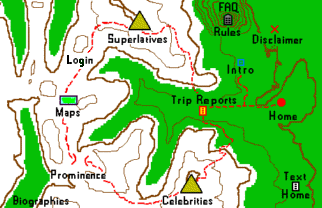
| Class Ratings Definitions * |

|
There have been some questions raised about whether this system is a difficulty rating or a danger rating. Mountaineers have traditionally used it as the former since long before there was any county highpointing. So, in that sense, one should not define it according to the exposure. If that becomes a question, I deal with it by extrapolating the surface I'm actually on below me, and then I ask myself what the exposure would be.
Examples: The key ledge of the Le Conte route on North Palisade is class 2. Although the exposure below is severe, it is not representative of the surface you're actually on, which requires (very careful!) use of hands for balance, but not much more. The ledge behind the Keyhole on Longs Peak is class 1 or 2. Although it's nearly vertical above and below, and people have died falling off it, the dropoff would not have been "predicted" if one extrapolated the surface down below.John Mitchler offers, somewhat tongue-in-cheek, alternative class definitions using both a difficulty metric and an exposure metric.
| back to Superlatives page | view class ratings map |